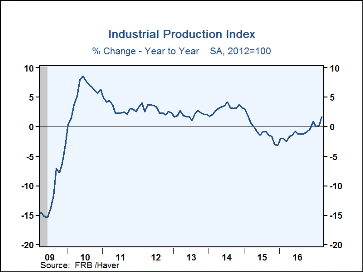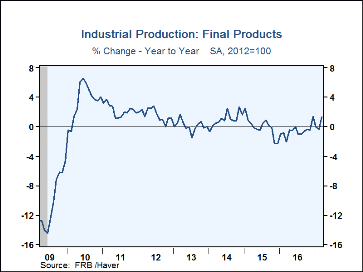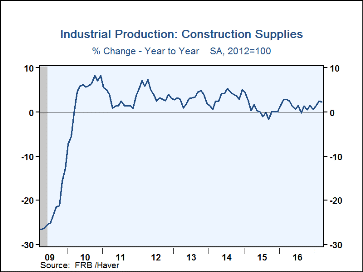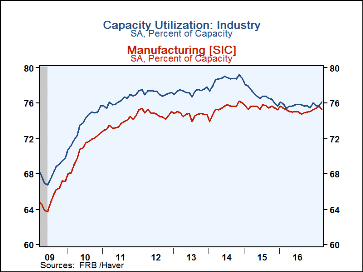 Global| Apr 18 2017
Global| Apr 18 2017U.S. Industrial Production Increases, but Factory Output Falls
by:Tom Moeller
|in:Economy in Brief
Summary
Industrial production strengthened 0.5% during March (1.6% y/y) following a 0.1% February uptick, revised from no change. A 0.4% increase had been expected in the Action Economics Forecast Survey. Earlier figures reflect benchmark [...]
Industrial production strengthened 0.5% during March (1.6% y/y) following a 0.1% February uptick, revised from no change. A 0.4% increase had been expected in the Action Economics Forecast Survey. Earlier figures reflect benchmark revisions. Manufacturing sector output declined 0.4% (+0.8% y/y) and reversed February's 0.3% increase. Utilities output surged 8.6% (4.6% y/y). Mining output improved 0.1% (3.0% y/y) following strong gains during the prior two months.
Production of final products rose 0.8% (1.3% y/y) after two months of decline. Output of construction supplies declined 0.8% (+2.3% y/y) following two months of 1.4% increase. Business equipment also fell 0.4% (+0.7% y/y) following little change during the prior two months. A 1.2% increase (1.3% y/y) in consumer goods production offset this weakness. Nondurable, nonenergy consumer goods production rose 0.2% (-0.7% y/y) driven by a 1.2% rise (-3.0% y/y) in chemical output. Clothing production fell, however, by 1.6% (-6.5% y/y). Durable consumer goods output declined 1.7% (+2.1% y/y), as auto production fell 2.5%(+2.9% y/y). Output of computers, audio and video product production gained 0.5% (1.6% y/y) after falling for two months.
Materials production increased 0.4% (1.6% y/y), held back by a 1.0% decline (-0.5% y/y) in textile product output. Production of energy materials jumped 2.0% (2.4% y/y), but durable materials production fell 0.9% (+1.6% y/y).
Amongst the special aggregate series, high-technology product production increased 0.4% (5.8% y/y) after two months of decline. Factory output excluding high technology products fell 0.5% (+0.6% y/y). Factory output excluding both high-tech and motor vehicles eased 0.2% (+0.6% y/y).
Capacity utilization increased to 76.1%, its highest point since January 2016. Factory sector utilization, however, fell to 75.3%, its lowest point in three months. Factory sector capacity rose a steady 0.7% y/y.
Industrial production and capacity data are included in Haver's USECON database, with additional detail in the IP database. The expectations figure is in the AS1REPNA database.
The End of China's Export Juggernaut from the Federal Reserve Bank of New York is available here.
| Industrial Production (SA, % Change) | Mar | Feb | Jan | Mar Y/Y | 2016 | 2015 | 2014 |
|---|---|---|---|---|---|---|---|
| Total Output | 0.5 | 0.1 | -0.3 | 1.6 | -1.2 | -0.7 | 3.1 |
| Manufacturing | -0.4 | 0.3 | 0.4 | 0.8 | -0.0 | 0.1 | 1.2 |
| Consumer Goods | 1.2 | -0.7 | -1.1 | 1.3 | 0.6 | 2.3 | 0.8 |
| Business Equipment | -0.4 | 0.1 | 0.0 | 0.7 | -1.8 | -0.9 | 1.9 |
| Construction Supplies | -0.8 | 1.4 | 1.4 | 2.3 | 1.3 | 0.5 | 3.4 |
| Materials | 0.4 | 0.4 | 0.0 | 1.6 | -2.3 | -1.4 | 5.1 |
| Utilities | 8.6 | -5.8 | -6.8 | 4.6 | -0.3 | -0.7 | 1.4 |
| Mining | 0.1 | 2.9 | 1.3 | 3.0 | -9.1 | -4.3 | 10.7 |
| Capacity Utilization (%) | 76.1 | 75.7 | 75.7 | 75.4 | 75.7 | 76.8 | 78.6 |
| Manufacturing | 75.3 | 75.6 | 75.4 | 75.2 | 75.1 | 75.5 | 75.4 |
Tom Moeller
AuthorMore in Author Profile »Prior to joining Haver Analytics in 2000, Mr. Moeller worked as the Economist at Chancellor Capital Management from 1985 to 1999. There, he developed comprehensive economic forecasts and interpreted economic data for equity and fixed income portfolio managers. Also at Chancellor, Mr. Moeller worked as an equity analyst and was responsible for researching and rating companies in the economically sensitive automobile and housing industries for investment in Chancellor’s equity portfolio. Prior to joining Chancellor, Mr. Moeller was an Economist at Citibank from 1979 to 1984. He also analyzed pricing behavior in the metals industry for the Council on Wage and Price Stability in Washington, D.C. In 1999, Mr. Moeller received the award for most accurate forecast from the Forecasters' Club of New York. From 1990 to 1992 he was President of the New York Association for Business Economists. Mr. Moeller earned an M.B.A. in Finance from Fordham University, where he graduated in 1987. He holds a Bachelor of Arts in Economics from George Washington University.










